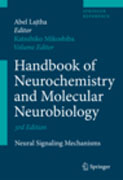
Handbook of neurochemistry and molecular neurobiology: neural signaling mechanisms
Mikoshiba, K.
This volume of the Handbook of Neurochemistry and Molecular Biology focuses on molecular events involved in synapse formation, synaptic plasticity and ongoing neural activity. The volume explores axonal growth cones, synapse development, and mechanisms of LTP and LTD, and calcium dynamics. Particular attentionis given to function and trafficking of membrane proteins including various ion channels, aquaporines, gap junctions. Explores synaptic signaling and development from a neurochemistry perspective e-reference contains crosslinking to other references Useful for basic neuroscientists and molecular biologists INDICE: From the contents Molecular events occurring during neural activity.- Molecular events occuring during synaptic plasticity.- molecular mechanismof growth come formation.- molecular mechanism of LTP in hippocampus.- Molecular mechanism of LTD in cerebellum.- Development of synapse.- Ion channels, neural function and disease.- Aquaporine.- NMDA receptor.- C1-channel.- gap junction.- AMPA receptor.- nACH receptor.- K channel.- muscarinic receptor.- glycine receptor.- GABA receptor.- Glutamate receptor.- Ca channel.- Catecholamine receptor.- Indolamine.- Phosphorylation.- Protein kinase C.- BARK.- CaMK II.- cdk5.- P13 kinase.- Postsynaptic signaling.- Presynaptic signaling.- Dynamism of ion channels and receptors: targeting, trafficking, degradation.- Structural basis of ion channel gating and pore opening.- Calcium signaling.- calineurin.- IP3 receptor.- calreticulin.- Ryandine receptor.- Calcium channel.- Ca pump.- Signaling molecules.- PLC.- PLD.- MgluR.- inositolpolyphosphates includingPIP2.
- ISBN: 978-0-387-30338-3
- Editorial: Springer
- Encuadernacion: Cartoné
- Páginas: 632
- Fecha Publicación: 01/06/2009
- Nº Volúmenes: 1
- Idioma: Inglés
